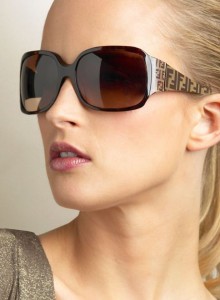A little more detail about my earlier post on Sunglasses and eye protection.
 The classic rock band ZZ Top told us to buy cheap sunglasses, but is this good advice? Perhaps not. Cheap glasses are often made of brittle acrylic plastic, which can shatter and cause eye damage. And they scratch easily. Better glasses are made with polycarbonate or CR 39, which are more resistant to shatter, and are also light weight. Make sure the lenses are 100% UV rated to provide maximum protection.
The classic rock band ZZ Top told us to buy cheap sunglasses, but is this good advice? Perhaps not. Cheap glasses are often made of brittle acrylic plastic, which can shatter and cause eye damage. And they scratch easily. Better glasses are made with polycarbonate or CR 39, which are more resistant to shatter, and are also light weight. Make sure the lenses are 100% UV rated to provide maximum protection.
Also, frames should wrap around the sides, to protect from glare. This is particularly important where there is lots of reflected light — in snow, or on a lake.
It is not necessary to spend a lot of money to get the protection you need from your sunglasses. But don’t just buy them because they’re cheap, or they look cool. Read the labels and do your homework. Also, avoid the glasses that have lots of jewels all over them. They just look silly.


Sunglasses definitely make you look cool, but there’s a more important reason to wear them. Just as we protect our skin from sun damage, we have to protect our eyes. UV radiation causes cataracts, and other problems with the surface of the eye, and possibly even the retina.
If you live in the mountains, it is even more critical. That’s because the amount of UV radiation that your eyes are exposed to increases by 4% for every 1000 feet above sea level. So if you drive to Lake Tahoe, you have 24% more UV than in Sacramento . This adds up. When the sun is at its peak, there is maximum UV radiation in the environment, but when the sun dips down, there is more reflection of UV into your eyes.
All this UV is certainly bad for our eyes, and can cause vision problems, but it can also cause squinting, and perhaps the most dreaded side effect of all–wrinkles.

Approximately 200,000 new cases of breast cancer will be diagnosed in the U.S. this year, according to several estimates.
But here’s another statistic: There are 2.5 million American women now alive who have survived this disease.
Early detection is the key to survival.
The American Cancer Society suggests that women perform routine breast self exams in their twenties, while having clinical exams every three years. At 40, women should start having annual screening mammograms.
A screening mammogram is a low-dose x-ray picture of the breast. It can detect tumors too small to feel, along with other suspicious indicators of cancer. A diagnostic mammogram is a more thorough follow up, using additional views. It can reveal a false positive reading, or confirm signs of cancer.
Women with hereditary or other risks should be especially diligent in having routine screenings and talk to their physician.
For every woman, it’s worth doing.
 The classic rock band ZZ Top told us to buy cheap sunglasses, but is this good advice? Perhaps not. Cheap glasses are often made of brittle acrylic plastic, which can shatter and cause eye damage. And they scratch easily. Better glasses are made with polycarbonate or CR 39, which are more resistant to shatter, and are also light weight. Make sure the lenses are 100% UV rated to provide maximum protection.
The classic rock band ZZ Top told us to buy cheap sunglasses, but is this good advice? Perhaps not. Cheap glasses are often made of brittle acrylic plastic, which can shatter and cause eye damage. And they scratch easily. Better glasses are made with polycarbonate or CR 39, which are more resistant to shatter, and are also light weight. Make sure the lenses are 100% UV rated to provide maximum protection.
